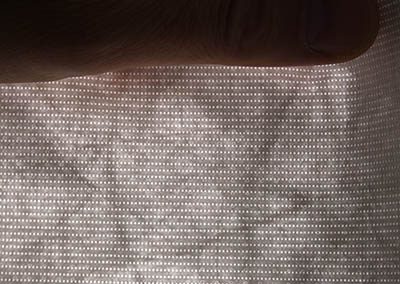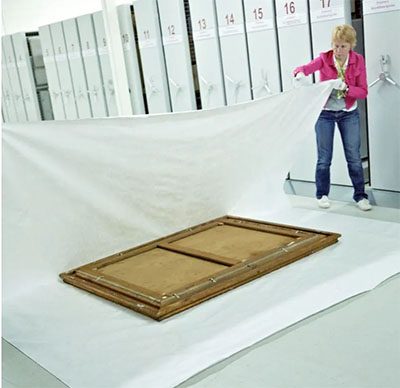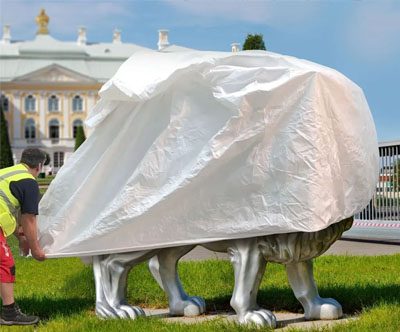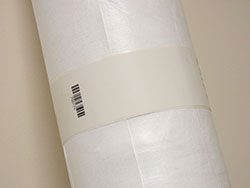The materials we use every day are under increased scrutiny to ensure that we are making the most informed decisions when it comes to sustainability. When a material like Tyvek is mentioned, alarm bells can ring for some. So, what is Tyvek? What do we use it for? should we continue using it? and is it a sustainable choice?

What is Tyvek?
Tyvek isn’t just for conservation
There are many grades of Tyvek, for the purposes of this article we will be talking about the grades that are used in conservation, those are; 1422R, 1623E, and 1560K . Other grades of Tyvek are available for other industry specific purposes, such as building and roofing materials, printing and industrial shipping or packaging which may not be suitable for conservation purposes – often this is confused. Not all Tyvek is the same, this could also affect whether it can be recycled.
What is Tyvek Made Of?
Much of the concern regarding the sustainability of Tyvek is that it is made from spunbonded high-density polyethylene (HDPE). It is a plastic derived from fossil fuels.
What Does Tyvek Look and Feel Like?
The grades of Tyvek used in conservation are very smooth. It is very lightly textured, feels like paper but more flexible, like a fabric. Because it is spunbonded, the mesh of the strands in the material is random, this adds to the strength, the random strands cannot be easily torn or punctured like paper or woven materials like cotton, and it doesn’t leave lint.

Why is Tyvek Popular?
- It doesn’t tear easily and is very strong despite being very light, even if it gets wet.
- It’s not hygroscopic so will not easily absorb water.
- Will not be eaten by common museum pest insects.
- Doesn’t leave lint even when cut.
- Is essentially inert (except in UV light) and acid-free safe for direct contact with most objects.
- Smooth surface is unlikely to imprint or abrade over time.
- Can be cut with scissors, sewn, welded and written upon.
- Filters out 99.9% of particles to 0.5-0.7 micron in size but is still breathable.
- It is also trusted in conservation and is often used without thought to any alternative.
How Does All of This Apply to Sustainability?
What Are the Sustainability Issues with Tyvek?
- It can be difficult to recycle (I.e it is not part of a roadside collection scheme or recycled at normal recycling centres), but it can be recycled.
- It is slow to degrade which is good for conservation use but not in a landfill waste situation.
- The plastic used is derived from fossil fuels.
- 1sqm of Tyvek has an approximate carbon footprint of 0.102 tCO2, and 0.238 GHG (Greenhouse Gas Unit).

What Could You Use in Place of Tyvek?
Cotton/Linen - Tyvek is often used as temporary cover to prevent dust and debris from collecting on larger objects like furniture, frames, bookcases, sculptures and more. Cotton/linen dust sheets can also be used for the same purpose. Cotton is a natural and renewable material which can be easily recycled, washed and is biodegradable. Cotton is also more resistant to high temperatures and will not melt or combust easily. There are some sustainability questions regarding the manufacture of cotton as large amounts of water are used in production, as well as GHG emissions (1.225 GHG sqm) could be up to 5x higher than Tyvek (ref. stich.culturalheritage.org). Only by producing a full life-cycle analysis is it possible to see the full picture on how sustainable any cotton product is. Cotton is susceptible to textile pests and can become damp attracting mould growth in the wrong conditions.
Acid-Free Tissue/Paper – Tyvek might also be used as a cover for smaller objects in storage or transport. Acid-free tissue or acid-free paper could be used in its place in some circumstances. Paper is renewable and biodegradable. Only by producing a full life-cycle analysis is it possible to see the full picture on how sustainable any paper product is. You can view our acid-free papers here.
How Can You Make the Tyvek You Use More Sustainable?
Sometimes your choices are restricted by the type of application you are using the material for. So, when you do need to use Tyvek, how can you make sure that you are using it in the most sustainable way?

- Washing Tyvek – Soiled Tyvek can be wiped with a damp cloth or gently hand-washed in cold water with a mild detergent, like Orvus paste. Allow to air dry, you must not tumble-dry as this can both melt the material or cause delamination of the fibres, as can machine washing. Keeping the material clean can extend the working life of used Tyvek or allow it to be repurposed onsite. This includes uncontaminated PPE suits.
- Use the Correct Material When Exposed to Sunlight – Extended exposure to UV light can damage standard Tyvek grades 1422R, 1623E and 1073D causing it to breakdown prematurely. When prolonged exposure to sunlight is expected you could use grade 1560K. Tyvek 1560K's properties mean it can last up to 10 times as long as standard grades of Tyvek when used in exposed areas, meaning less frequent requirement for replacing material and prevention of waste going to landfill. Tyvek 1560K is the grade you would need to use for any external application. Other renewable alternatives, such as cotton/linen, may be considered when being used inside a property, but not where they may become wet.
- Using Offcuts/Repurposing – Offcuts of material can be used for other small projects e.g.; making bags/pockets, cushions, labels and more. Because the material is so versatile it can be used for many different applications and even the smallest of offcuts can be utilized. The most sustainable use of any waste Tyvek is repurposing in-house as this doesn’t involve any further manufacturing or shipping processes.
- Recycle Waste – Any waste Tyvek can be recycled, as it is made from HDPE it is endlessly recyclable. You would need to contact your local recycling centers to see if they are able to process the material.
- Storing Unused Material - If Tyvek is being purchased for a particular project and used temporarily, once complete it can be rolled back up onto a tube and stored for future use. Tyvek can be stored for many years indoors under controlled temperature and humidity. It shouldn’t be stored in direct sunlight. Tyvek is best stored vertically on its ends.
- Use Tyvek Instead of a Single-Use Material – Because Tyvek is strong and can be reused and stored for many years it may be a more sustainable option than a single-use or limited-use material.
> | View all Tyvek products here

Small Changes Make Big Differences – We've been looking at what we can do as a business to reduce our impact on the planet and reducing waste is an important aspect of this. As a result of our own experience and seeking a better solution, PEL will be changing the way we secure our Tyvek rolls. Previously, like most manufacturers, we have used adhesive tape to secure our rolls of material. As this tape adheres to the material it often damages the surface when removed for use, meaning the entire outer layer is frequently discarded, this can be as much as 50cm (length) of material on our larger rolls. Our new paper fixtures solve this issue as they stick to themselves rather than the roll. This small change will have a big impact and we estimate this could save between 1,500 and 3,500 square meters of materials being unnecessarily discarded every year by our customers. This is a significant reduction in waste that in isolation, on a single roll, could have appeared insignificant.
Conclusion
Alternative renewable materials are available to perform some of the tasks that Tyvek is used for, but they have some shortcomings and are not as versatile in a conservation setting. Waste Tyvek can be recycled or repurposed provided that it is not contaminated. If Tyvek is likely to become heavily soiled/contaminated or damaged by prolonged UV exposure or heat, and as a result discarded rather than reused or recycled, then a renewable alternative is possibly the least impactful solution and prevents plastic from going to landfill. Tyvek is made from a plastic that is derived from fossil fuels but is not considered single-use and should provide many years of service provided the correct grade is selected, as a result, its impact on the environment is reduced. The overall sustainability of Tyvek is dependent upon its usage and minimizing waste.
References:
Independent report from Lorraine Finch ACR - Abbreviated report available on request. You can find Lorraine Finch’s book on sustainability in cultural heritage here.
Dupont - https://www.dupont.com/tyvekdesign/design-with-tyvek/dupont-tyvek-faq.html
STiCH stands for Sustainability Tools in Cultural Heritage - https://stich.culturalheritage.org/